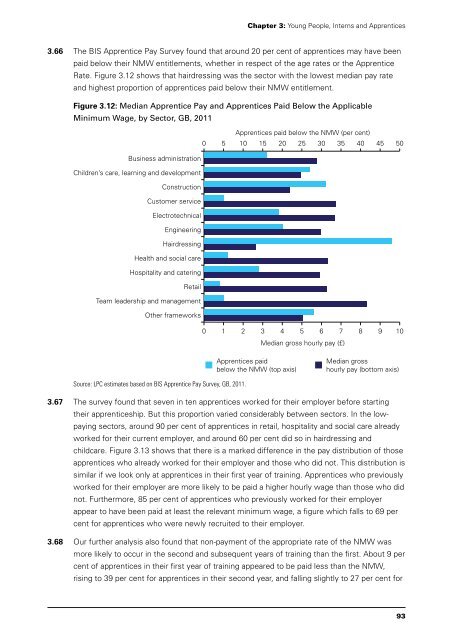National Minimum Wage
National Minimum Wage
National Minimum Wage
Create successful ePaper yourself
Turn your PDF publications into a flip-book with our unique Google optimized e-Paper software.
Chapter 3: Young People, Interns and Apprentices<br />
3.66 The BIS Apprentice Pay Survey found that around 20 per cent of apprentices may have been<br />
paid below their NMW entitlements, whether in respect of the age rates or the Apprentice<br />
Rate. Figure 3.12 shows that hairdressing was the sector with the lowest median pay rate<br />
and highest proportion of apprentices paid below their NMW entitlement.<br />
Figure 3.12: Median Apprentice Pay and Apprentices Paid Below the Applicable<br />
<strong>Minimum</strong> <strong>Wage</strong>, by Sector, GB, 2011<br />
Business administration<br />
Children’s care, learning and development<br />
Construction<br />
Customer service<br />
Electrotechnical<br />
Engineering<br />
Hairdressing<br />
Health and social care<br />
Hospitality and catering<br />
Retail<br />
Team leadership and management<br />
Other frameworks<br />
Source: LPC estimates based on BIS Apprentice Pay Survey, GB, 2011.<br />
Apprentices paid below the NMW (per cent)<br />
0 5 10 15 20 25 30 35 40 45 50<br />
0 1 2 3 4 5 6 7 8 9 10<br />
Median gross hourly pay (£)<br />
Apprentices paid<br />
below the NMW (top axis)<br />
Median gross<br />
hourly pay (bottom axis)<br />
3.67 The survey found that seven in ten apprentices worked for their employer before starting<br />
their apprenticeship. But this proportion varied considerably between sectors. In the lowpaying<br />
sectors, around 90 per cent of apprentices in retail, hospitality and social care already<br />
worked for their current employer, and around 60 per cent did so in hairdressing and<br />
childcare. Figure 3.13 shows that there is a marked difference in the pay distribution of those<br />
apprentices who already worked for their employer and those who did not. This distribution is<br />
similar if we look only at apprentices in their first year of training. Apprentices who previously<br />
worked for their employer are more likely to be paid a higher hourly wage than those who did<br />
not. Furthermore, 85 per cent of apprentices who previously worked for their employer<br />
appear to have been paid at least the relevant minimum wage, a figure which falls to 69 per<br />
cent for apprentices who were newly recruited to their employer.<br />
3.68 Our further analysis also found that non-payment of the appropriate rate of the NMW was<br />
more likely to occur in the second and subsequent years of training than the first. About 9 per<br />
cent of apprentices in their first year of training appeared to be paid less than the NMW,<br />
rising to 39 per cent for apprentices in their second year, and falling slightly to 27 per cent for<br />
93


